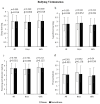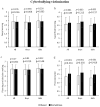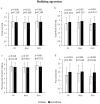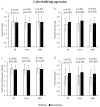Bullying and cyberbullying. A high risk, in boys and girls, of superficial learning, poor planning and academic procrastination
- PMID: 40709227
- PMCID: PMC12286959
- DOI: 10.3389/fpsyg.2025.1567523
Bullying and cyberbullying. A high risk, in boys and girls, of superficial learning, poor planning and academic procrastination
Abstract
The aim of the present study was to analyse the association of bullying and cyberbullying with deep learning, superficial learning, planning and decision making, as well as school procrastination. A total of 1,263 Spanish schoolchildren (51.39% girls) aged 10-16 years (13.23 ± 1.77) participated. The association between variables and the analysis of exposure risk was performed by analysis of covariance (ANCOVA) and binary logistic regression, respectively. All analyses were conducted separately for boys and girls and adjusted for age, body mass index, mother's education and average weekly physical activity. Results showed that girls who were victims of bullying and cyberbullying had significantly higher procrastination toward class tasks (7 and 16%, respectively). In addition, cyberbullying victims acquire more superficial learning (5.28%). In general, victims of bullying have almost twice the risk of having higher values of superficial learning and procrastination than non-victims. This risk is multiplied by 3 and 4, respectively, in the case of cyberbullying victims. On the other hand, bullying aggressors were also found to have high superficial learning (7.34%) and higher procrastination (17.45%). In the case of cyberbullying, aggressors also had more superficial learning (boys = 13.38% and girls = 9.56%), worse values in planning and decision making (boys = 3.82% and girls = 3.3%) and more procrastination (boys = 16.81% and girls = 20.48%). In both sexes, the risk of exposure to aggression toward the above variables is multiplied by 8, 2, and 10, respectively. All these findings reveal that bullying and cyberbullying can affect young people in key learning variables, beyond those of physical, psychological or socio-emotional aspects already known. Immediate and systematic actions are needed to monitor and prevent bullying and cyberbullying inside and outside the school context, creating safe spaces and providing counseling for both victims and aggressors.
Keywords: aggression; bullying; cyberbullying; decision-making; learning; schoolchildren; teaching; victimization.
Copyright © 2025 Rusillo-Magdaleno, de la Torre-Cruz, Martínez-Redecillas and Ruiz-Ariza.
Conflict of interest statement
The authors declare that the research was conducted in the absence of any commercial or financial relationships that could be construed as a potential conflict of interest. The author(s) declared that they were an editorial board member of Frontiers, at the time of submission. This had no impact on the peer review process and the final decision.
Figures




Similar articles
-
Bullying and Cyberbullying Are Associated with Inappropriate Use of the Internet, Cell Phones, and Video Games in Children and Adolescents.Eur J Investig Health Psychol Educ. 2025 May 15;15(5):82. doi: 10.3390/ejihpe15050082. Eur J Investig Health Psychol Educ. 2025. PMID: 40422311 Free PMC article.
-
Identifying and Addressing Bullying.2023 Dec 13. In: StatPearls [Internet]. Treasure Island (FL): StatPearls Publishing; 2025 Jan–. 2023 Dec 13. In: StatPearls [Internet]. Treasure Island (FL): StatPearls Publishing; 2025 Jan–. PMID: 28722959 Free Books & Documents.
-
Comparison of Two Modern Survival Prediction Tools, SORG-MLA and METSSS, in Patients With Symptomatic Long-bone Metastases Who Underwent Local Treatment With Surgery Followed by Radiotherapy and With Radiotherapy Alone.Clin Orthop Relat Res. 2024 Dec 1;482(12):2193-2208. doi: 10.1097/CORR.0000000000003185. Epub 2024 Jul 23. Clin Orthop Relat Res. 2024. PMID: 39051924
-
Systemic pharmacological treatments for chronic plaque psoriasis: a network meta-analysis.Cochrane Database Syst Rev. 2021 Apr 19;4(4):CD011535. doi: 10.1002/14651858.CD011535.pub4. Cochrane Database Syst Rev. 2021. Update in: Cochrane Database Syst Rev. 2022 May 23;5:CD011535. doi: 10.1002/14651858.CD011535.pub5. PMID: 33871055 Free PMC article. Updated.
-
Systemic pharmacological treatments for chronic plaque psoriasis: a network meta-analysis.Cochrane Database Syst Rev. 2017 Dec 22;12(12):CD011535. doi: 10.1002/14651858.CD011535.pub2. Cochrane Database Syst Rev. 2017. Update in: Cochrane Database Syst Rev. 2020 Jan 9;1:CD011535. doi: 10.1002/14651858.CD011535.pub3. PMID: 29271481 Free PMC article. Updated.
References
-
- Alotaibi N. B. (2019). Cyber bullying and the expected consequences on the students' academic achievement. IEEE Access 7, 153417–153431. 10.1109/ACCESS.2019.2947163 - DOI
LinkOut - more resources
Full Text Sources

